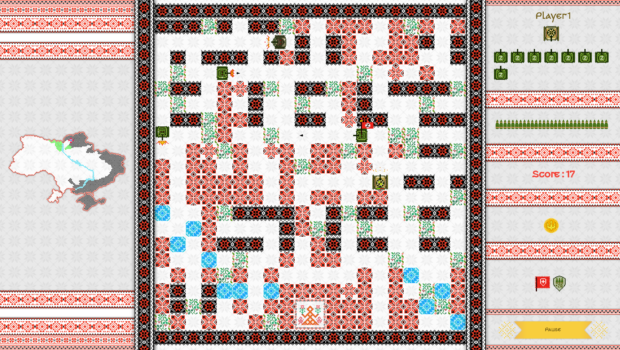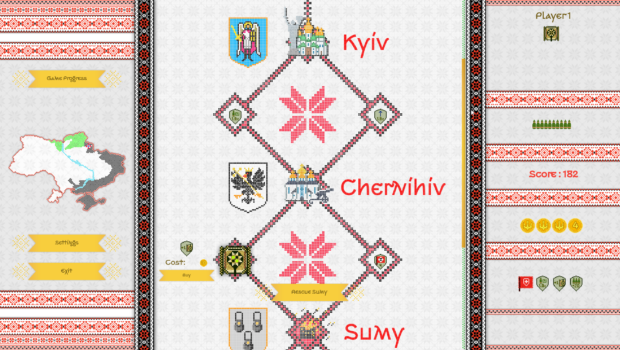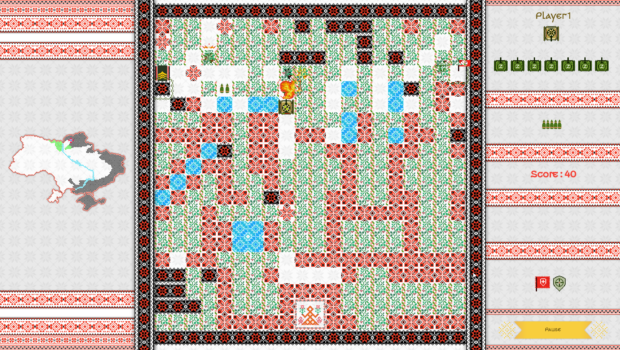Project Introduction
== Battle Mechanics ==We based our game on the Battle City mechanics but completely reworked them from scratch because they are outdated and dull by today's standards.
Firstly, we defined our core principle: the game places less emphasis on reaction or accuracy and more on the ability to prioritise effectively. Therefore, the battle mechanics are designed to encourage the player to make decisions and execute them as well as possible.
- Let's recall some basic Battle City mechanics: the level features four types of blocks: brick (can be destroyed by shooting at them), metal (indestructible), forest (reduces the visibility of tanks), and water (blocks movement but allows shooting through).
- We expanded the battlefield compared to Battle City.
- Introduced a reload mechanic.
- Ammo depletes. However, when an enemy tank is destroyed, it drops some ammo. If there is no ammo on the level, it spawns randomly. This encourages the player to move around to collect ammo.
- A special shot mechanic created (shooting with SPACE, special shooting with CTRL). It does not use up ammo, and although it doesn't damage enemy tanks, it can destroy bricks.
- If the player destroys an enemy tank from behind, an upgrade icon appears randomly on the map for a short time (5 seconds).
- If the player collects it, their tank is upgraded, up to four levels maximum. Each upgrade provides an additional shield and increases movement and reload speed by 10%. This mechanic encourages players to choose the right timing and direction for their shots and to move towards the bonus.
- Some enemy tanks are Commander tanks (identifiable by a red flag). Destroying one triggers a powerful bonus to appear randomly on the map (which will vanish after about 5 seconds). If the player captures this bonus, they gain a significant advantage, such as 30 seconds of invulnerability or a 50% reduction in enemy movement for 30 seconds (there are several different bonuses).
These mechanics are designed to make the battles engaging and generate interesting emergent situations.
== Progression System ==
The player starts in Hostomel (where the world's largest aircraft, "Mriya," was destroyed), continues through Kyiv, liberates a series of other cities, and culminates in the final "boss" battle of 2022: the battle for Kherson. Between cities, players choose bonuses that influence their gameplay style. Levels increase in difficulty, and occasionally players will confront mini-bosses.
Character death results in defeat. However, players will accrue experience and unlock new bonuses that appear between battles.
Overall, the progression system is akin to that of Monster Train.
== Bonuses ==
Bonuses are of two types: passive and active.
Passive bonuses provide background advantages. For example, they might increase reload speed, grant invulnerability in forest tiles, provide +20 starting ammo, or make bullets travel faster albeit with a slightly slower reload time (there will be many passive bonuses).
Active bonuses differ. When the player destroys a Commander tank, an active bonus icon appears on the map. The specific active bonus that appears depends on the player's existing bonuses. For example, if the player has the bonuses "Invulnerability" and "2x Shooting Speed," one of these is randomly selected to appear on the map. If the player secures this bonus in time, they receive its effects for 30 seconds.
There are some passive bonuses that synergise with active ones, allowing players to tailor their builds.
About Developer
Andriy Kostiushko is the co-owner of Creoteam and a seasoned game designer with 18 years of industry experience. His most famous game, Football, Tactics & Glory, holds an 88% rating from approximately 3,500 reviews on Steam. The game has a reward Best Desktop Game Dev Gamm 2016.In addition to his proficiency in game design, Andriy is partially skilled in drawing, music production, and writing. For Threads of War, he is responsible for the game design, graphics, and music.
Askold Kostiushko is an 11-year-old programmer who began his programming education at the age of 5. By the age of 9, he was already developing simple games using the Godot engine and releasing them on itch.io. Threads of War represents his most significant and challenging project thus far. Askold has independently written all the code for the demo version of Threads of War.




